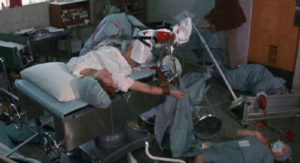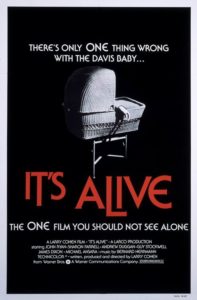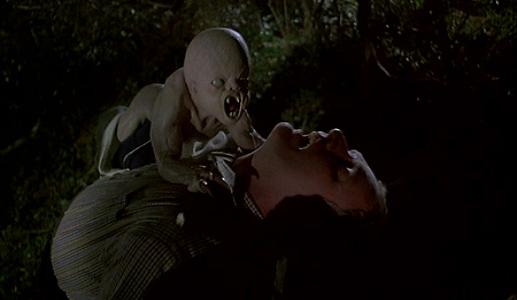This article contains spoilers for IT’S ALIVE.
The MPAA ratings system was not introduced until 1968. Quite frankly, for roughly the first ten years of its existence, the MPAA seemed to have no idea how to use it. To clarify, I am referring to the time well before accusations of such conspiracies as lenient ratings being given to studio films, independent films given harsher ratings, and the crusade against gore in ’80s horror films. I actually do believe that when the ratings system was initially put in place, it was with the best intentions of guiding audiences through a changing time as films developed more realistic dialogue (complete with horrifying words like “shit” and “fuck” that were guaranteed to turn the innocent deaf), sex that didn’t involve panning over to a roaring fireplace (or fireworks, or a train entering a tunnel, or a rushing waterfall, etc.), and violence that resulted in bloody fatalities.
But there were wild inconsistencies in what was and was not “allowable” content. Movies like A CLOCKWORK ORANGE and LAST TANGO IN PARIS were given deserved X ratings (back when that rating wasn’t synonymous with films featuring hardcore sex) while PLANET OF THE APES and THE GREEN BERETS, featuring Charlton Heston’s bare ass and men bloodily impaled on spikes, respectively, were confusingly given the family friendly G rating. But there is a whole other article that could be written on the illogical content to rating equation of the late ’60s-mid ’70s and I do not feel like writing that article today. My only goal now is to piggyback off of Johnny Donaldson’s excellent piece on the insane PG rating of THE BABY with the shock I have encountered in viewers at the tame rating given to one of my favorite films: IT’S ALIVE.
https://www.youtube.com/watch?v=aD9wL0ffxqY
The surprise of the PG rating for IT’S ALIVE does not come so much from actual onscreen violence/sex/language. Sure, there are moments in the film that remind you it’s a horror movie (quick insert shots of the mutant baby chowing down on human flesh, the bloody aftermath of the delivery room massacre, a character being torn apart by multiple gunshots), but what makes the film feel harsher than its rating is due more to its premise and tone of psychological violence.
There was very little actual “objectionable” content shown onscreen in IT’S ALIVE. The killings mostly happen off screen; the language is appropriately rough, but not overly profane; there is no nudity or sex. If you simply went by what was and what was not allowed on screen according to the loose guidelines for ratings, IT’S ALIVE easily slots into the PG rating of the time. Hell, if it had been released ten years later, it probably would have been one of the first PG-13 films, but still would most likely have avoided the R rating.

For a little over the last five years, I have been championing a “rediscovery” of Larry Cohen’s films on my blog, encouraging critics and dedicated movie viewers to consider him as a true auteur of American cinema. This has led to many conversations — both in person and online — with people watching IT’S ALIVE for the first time. One of the first things they mention is how much harsher the film was than they anticipated. The PG rating lulled them into a false sense of security that made them think a movie about a mutated baby that emerges from the womb with the teeth, claws, and survival instincts of a cornered grizzly bear would be cheesy fun. Instead, they get hit with images of bloody victims, a coldly analytical scientific community that talks pragmatically about the best way to kill the baby without doing too much damage — lest they not have the corpse to examine, and a borderline psychopath for a protagonist in Frank Davis (John P. Ryan).

The character of Frank Davis is where people really seem to balk at the film. He is difficult to pin down as he goes from slightly smug—but loving—husband and father to angry, tortured, wannabe alpha male obsessed with killing his own child so that people will stop seeing him as a freak (a viewpoint that is mostly in his head). The way Cohen and Ryan present Frank is not as a likable, but misguided guy. He is pompous, angry, fearful, and paranoid. After his baby is born a mutated killer, he mostly goes full asshole, slapping his wife when she “disobeys” him, actually wounding his baby in a shooting, and eagerly joining the police when they corner the baby in the Los Angeles sewers.
Frank’s eventual redemption, while actually earned by Cohen’s tight screenplay and Ryan’s finely tuned performance, is what usually pushed people over the edge as far what was considered the line between a horror flick deserving of a less restrictive rating and a tragic drama engaging in adult themes that requires the R rating. It is interesting to note that people who believe Frank should not have been redeemed and — therefore — killed by the baby, felt the film deserved the R rating for its more nuanced ending.
Throughout most of the film, Frank is set up as the Dr. Frankenstein to his monster. Ryan even nails a monologue about reading Mary Shelley’s novel as a teenager and discovering the title referred to the Doctor and not his creation. Cohen is clearly aware of what he is doing with the story and how he is leading the audience to think about where the film is going. But instead of the baby achieving his vengeance against the father who cast him out, Frank is forced to come face to face with the child he considered a monster and realizes how wrong he has been. Overcome with emotion, he grabs his child and engages in a doomed attempt to save him from the angry masses (in a prescient bit of storytelling, fearful, trigger-happy cops) that want to kill him. That he fails and his child is gunned down in a hail of bullets (along with one of the doctors so eager to examine the baby’s corpse) is apparently more of a tragedy than most people care to take.

It took me learning of first time viewer’s reactions to the film to understand why the PG rating it received felt so light. The ending, with Frank earning a measure of redemption, but unable to save his child, is as realistic as this type of fantastical horror film can have. Despite Ryan’s go-for-broke, moving performance, the conclusion is a tragedy that only feels partly cathartic. That Cohen’s ending to his own “Frankenstein” tale kills off only the monster while leaving the Doctor emotionally broken to try and pick up the pieces of his life feels too much of a tragedy for a PG rated film. Surely, the thinking seems to go, a genre movie with bloody killings, a gruesome premise, and so much psychological violence that traffics in heavy themes deserved a more restrictive rating than a PG?
But that was the beauty of the ratings system in the ’70s. Parents could takes their kids to see a PG-rated horror film at the drive in and unexpectedly be forced into deep conversations about morality, ironic comeuppance, and the fundamental lack of fairness when the Universe throws a curveball at people undeserving of such bad luck. Or those parents could ignore the conversation and drive home in stony silence, leaving their child to wonder if they were a mutant, would their father try to kill them as well?
Tags: Horror, Larry Cohen


No Comments